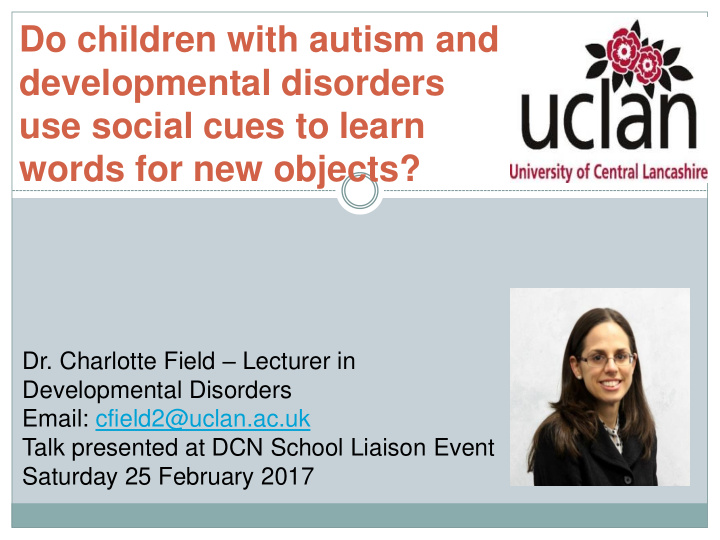



Do children with autism and developmental disorders use social cues to learn words for new objects? Dr. Charlotte Field – Lecturer in Developmental Disorders Email: cfield2@uclan.ac.uk Talk presented at DCN School Liaison Event Saturday 25 February 2017
“It’s a dax ”
Children’s word learning Age Word Learning 12 months Follow gaze and pointing. First words appear. 18 months – 2 years Learn words for object that speaker looks and/or points towards 3-4 years Use gaze to infer people’s needs, wants and desires 9 years + More advanced understanding, such as reading someone’s emotions from eye region
Word learning in children with ASD Autism Spectrum Disorder (ASD), by definition, involves difficulties with language and socialisation (American Psychiatric Association, 2000) Early studies suggested that children with ASD impaired learning words from social pragmatics (e.g. Baron-Cohen, Baldwin & Crowson, 1997; Preissler & Carey, 2005) Later studies argued that older / more verbally able children with ASD do learn words from speaker’s eye gaze and pointing (e.g. Akechi et al., 2011; Norbury, Griffiths & Nation, 2010)
Word learning in children with ASD cont. Studying word learning in Autism Spectrum Disorder (ASD) may: Help explain some aspects of the language and socialisation impairments shown by these children. Help those working with children with ASD show a better understanding of their difficulties, and so help us to help these children
My study No disability ASD Another DD (N = 30) (N = 27) (N = 21) Gender 18 boys, 12 girls 23 boys, 4 girls 14 boys, 7 girls Mean Chronological 4.15 9.93 8.61 Age Mean Verbal Mental 4.74 5.74 4.98 Age VMA measured by the British Picture Vocabulary Scale – Second Edition (BPVS_2)
Procedure / Results Children watched a series of videos where they saw a speaker look at and/or point to a novel object as they gave it a name (e.g. ‘ it’s a dax ’) Children with ASD and DD needed older VMA to learn words for this object (mean of 6, whereas even the younger children without developmental disorders understood these cues) Thus children with ASD are delayed learning words from eye gaze and pointing.
Why these results for children with DD too? Children with DD might also have impairments with using social cues (e.g. Franken, Lewis & Malone, 2010; Kasari, Freeman, Mundy & Sigman,1995; Laing, 2002) These results possibly due to executive functioning difficulties (e.g. paying attention to the task, remembering the new word) My future studies aim to directly test this, by including measures of children’s executive functioning ability (e.g. the Behaviour Rating of Executive Functioning – Second Edition – BRIEF 2 – scale) Also aim to recruit groups of children with different types of DD
Educational Implications Sometimes we take it for granted that children can understand our non verbal communication, such as eye gaze and pointing… ‘Look at me when I’m talking to you’ ‘Go and sit over there’ [ pointing to an empty chair at the back of the classroom ] Children with ASD/ DD may be delayed understanding these cues relative to children without
Educational Implications Sometimes children with ASD find it hard to process social information from eyes (Spezio, Adolph, Hurley & Piven, 2007) (even extends to adults with ASD; Klin, Jones, Schultz, Volkmar & Cohen, 2002) So, shouldn’t assume a child is being lazy, disobedient or difficult if they… Will not make eye contact Stare Do not appear to be following gestures
ANY QUESTIONS OR COMMENTS? ‘ It’s a dax !’ ‘ Show me a dax! ’
Recommend
More recommend